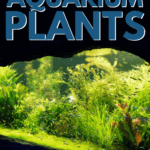Did you know that live plants bring many benefits to your fish tank’s ecosystem? Aquatic plants not only look beautiful in a freshwater aquarium, but they’re great for the health of your fish, removing harmful nitrates and CO2 from the water and oxygenating the tank.
But you need a brightly lit tank for plants to thrive, right? No, you don’t!
There are many medium light aquarium plants that grow in relatively poor light conditions, including low light aquarium plants for beginners that are surprisingly easy to care for.
In this comprehensive guide, we give you all the information that you’ll need to choose, care for, and propagate these undemanding plants. Also, we provide you with a detailed list of 37 of the best low light aquarium plants that you can grow in your tropical tank.
37 Best Low And Medium Light Aquarium Plants
When choosing plants for your aquarium, it pays to have a clear idea of whereabouts in the tank you want to put them. You’ll need some taller species for the back of the tank, a few mid-ground plants, and some small ones or carpet cover plants for the front of the setup.
1. Cryptocoryne Balansae
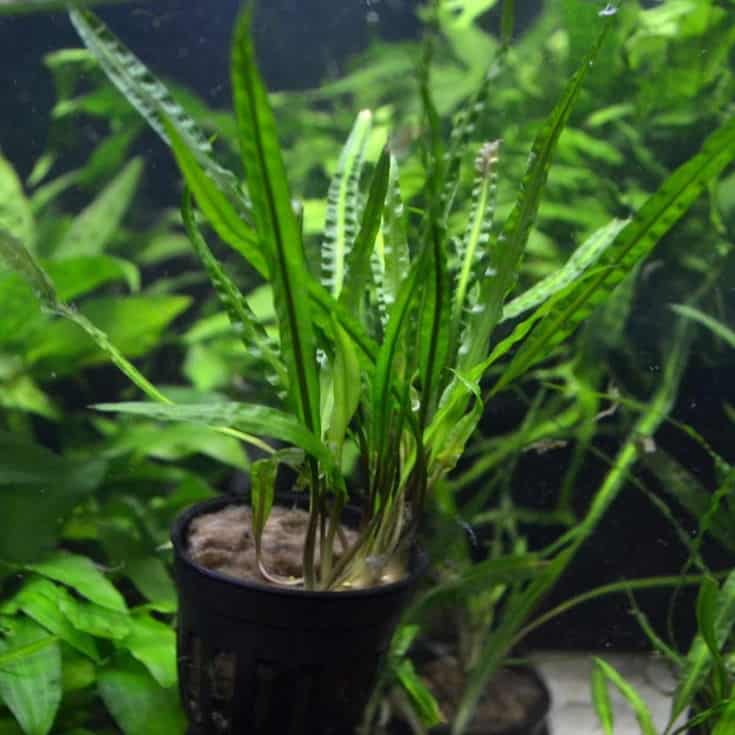
- Full name: Cryptocoryne crispatula “Balansae”
- Care difficulty: Easy to Moderate
- Light Level: Medium
Cryptocoryne Balansae is a large plant that comes from Southeast Asia and India. These plants are ideal for background plants in a medium to a large tank or as the centerpiece in a smaller setup, having large, unusually textured leaves that develop an attractive red underside.
These plants require stable water conditions and thrive in hard water. That said, Cryptocoryne Balansae is a very hardy plant that can even withstand the attention of boisterous fish, such as cichlids. This is a slow-growing plant that prefers low to moderate lighting. Once planted, the species does take a while to become established and doesn’t take kindly to being moved too much. The plant spreads by producing runners underneath the substrate that eventually grow into new plants.
You can encourage the plant to grow more rapidly by adding liquid fertilizer to the tank water once a week or so.
2. Anubias
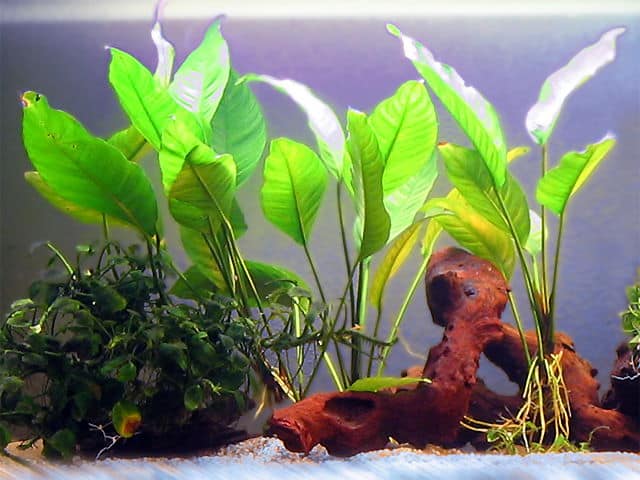
- Full name: Anubias Nana
- Care difficulty: Easy
- Light Level: Low
Anubias is a hardy, broad-leaved aquatic plant that comes from Africa, specifically Nigeria and Cameroon.
This plant grows to a maximum height of around 7.5 inches, so it is an ideal choice for a mid-ground or foreground plant in a medium-sized tank. The plant doesn’t require any special supplementation to thrive and will grow happily in low light conditions. You can plant Anubias in the substrate or attach it to pieces of wood or rocks with twine. Although you could leave it free-floating, the broad leaves may cut out too much light for lower dwelling plants.
Propagation happens by rhizome division. Simply snip off new plants as they appear on the rhizome, and replant them in the aquarium.
3. Amazon Sword
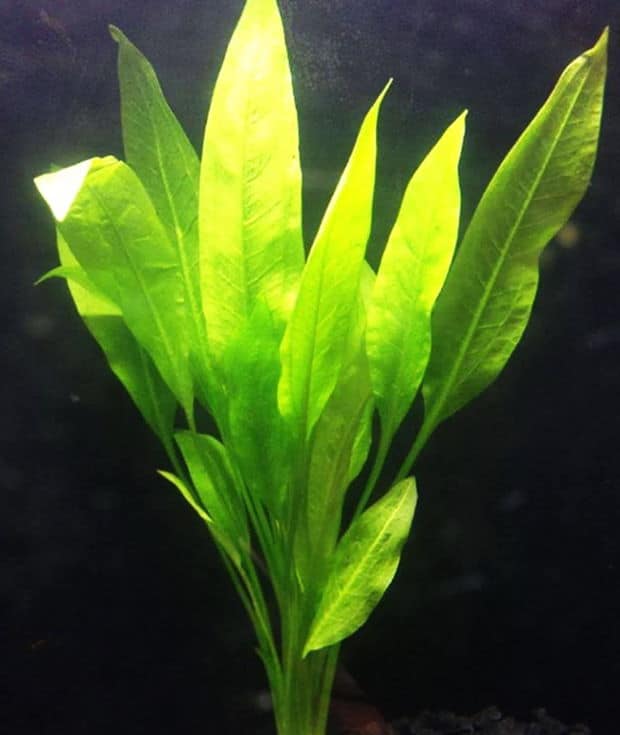
- Full name: Amazon Sword Plant (Echinodorus bleheri)
- Care difficulty: Easy to Moderate
- Light Level: Medium
The Amazon Sword is a broad-leaved species of a tropical plant that grows up to three feet tall in the wild environment. Luckily, the plant doesn’t reach those dizzying heights in an aquarium setting. However, I do recommend that you use these plants for medium to large tanks, rather than small setups.
Although the plants grow readily once they are established, you will need to securely anchor the plant securely in the substrate, as the broad leaves tend to catch the water flow in the tank, which can uproot the plant. Eventually, Amazon Sword sends out a long root system that will keep it firmly in place.
The plant can be propagated by pinching new plants from the submerged flowering stems and simply replanting them.
4. Cryptocoryne Spiralis
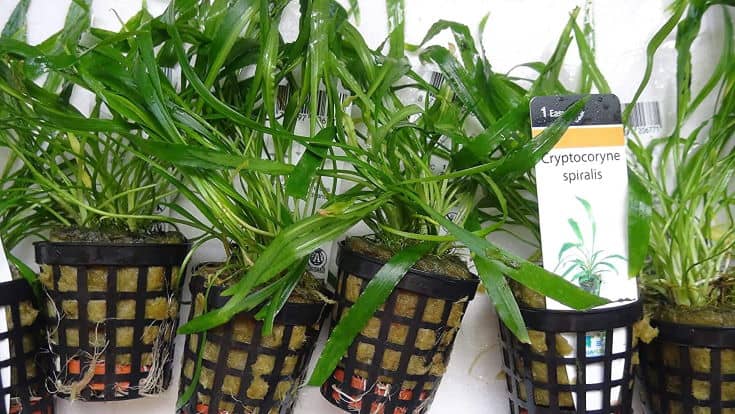
- Full name: Cryptocoryne Spiralis or Spiral Water Trumpet
- Care difficulty: Easy
- Light Level: Low to Medium
Cryptocoryne spiralis is also known by its common name of the Spiral Water Trumpet. As the name suggests, the plant has tall, narrow spiral-shaped leaves with wavy edges that are brownish-green in color.
The tropical plant comes from India, but it has proven to be a firm favorite with hobbyists who are looking for an attractive low light plant that can be used in the midground area of the tank.
This species is known to be very resistant to many common aquatic plant diseases, including Cryptocoryne rot. The plant prefers medium to hard water and grows most vigorously when provided with a nutrient-rich substrate and some liquid fertilizer.
Cryptocoryne spiralis is propagated by snipping off new plantlets from the parent plant and placing them into a pot of aquarium soil.
5. Cryptocoryne Usteriana
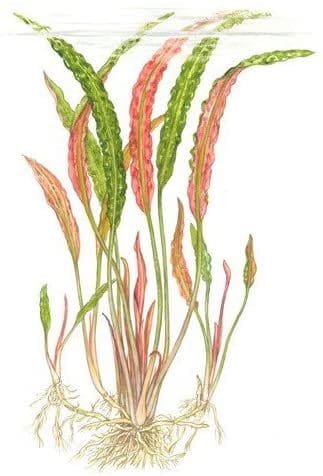
- Full name: Cryptocoryne Usteriana
- Care difficulty: Easy
- Light Level: Low to Medium
Cryptocoryne usteriana is a tall plant whose broad leaves can reach over 20 inches in length. So, these plants are best suited for life as background plants in your aquarium.
These plants are perfect for the beginner, as they are undemanding in terms of maintenance, even tolerating alkaline water without any ill effects. Even if you don’t add fertilizer to the water or substrate, Cryptocoryne usteriana grows well, producing wide leaves of a beautiful dark or bronze-green coloration with an unusual embossed surface and a beautiful burgundy red color on the back of the leaves.
If you do choose to supplement the plant’s nutrition, you can look forward to enjoying a good growth rate and exceptional color. You can propagate the plant easily by removing new plants from the long runners that the plant puts out underneath the substrate.
6. Rotala Rotundifolia
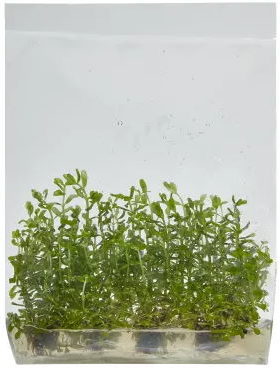
- Full name: Rotala Rotundifolia
- Care difficulty: Easy to moderate
- Light Level: Low to high
Rotala Rotundifolia’s name translates from the Latin as, “the plant with round leaves,” although that only applies to the wild marshland variety of the plant. The variety that you’ll find in your local fish store comes from Southeast Asia and is also sometimes advertised as Rotala Indica, although that is a different variety. The plant has long, narrow leaves set on 15 to 30 long stems.
The plant is relatively undemanding and can survive happily in medium light conditions. It’s worth noting that the plant will produce red leaves if it is given bright light levels. You will need to carry out some maintenance of Rotala Rotundifolia as if it’s left to its own devices; the plant will put out lots of side shoots. That results in compact, bushy growth, which makes it very difficult for light to get to the lower leaves. So, you may find that those lower leaves will die off. To keep the plant healthy, be sure to prune the lower leaves away from the plant once a week or so to keep it tidy.
7. Rotala Indica
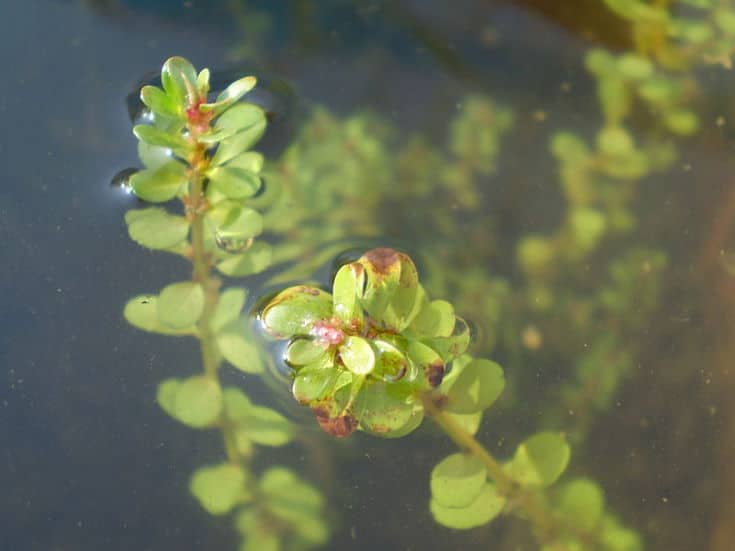
- Full name: Rotala Indica
- Care difficulty: Easy to moderate
- Light Level: Low to high
Rotala Indica comes from the same family as Rotala Rotundifolia above. The plant has long stems set with 15 to 30 small, round leaves that are pale green to brownish in color. The plant stems are long and can become trailing if not regularly pruned.
Like other variants within the species, Rotala Rotundifolia grows well in medium light conditions, although it will produce better coloration if the lighting is reasonably bright. Regular pruning is necessary to prevent the plant from becoming too bushy and producing lots of side growth, which deprives the lower leaves of light. Too little light encourages the plant to become spindly, and the bottom layers of leaves will eventually die off.
8. Vallisneria
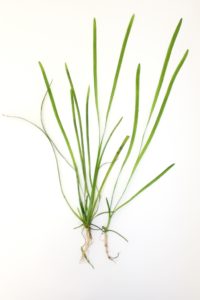
- Full name: Vallisneria
- Care difficulty: Easy
- Light Level: Low to high
Vallisneria is a very popular tropical aquarium plant that’s extremely useful in the aquarium for covering filtration equipment or simply to provide an attractive backdrop.
The plant grows in long, single leaves that resemble eelgrass. When it comes to maintenance, Vallisneria is pretty straightforward to care for, making it perfect for a beginner. To keep the plant looking good, all you need to do is snip away any excess growth, using a pair of aquascaping scissors.
There are several varieties of Vallisneria, including Vallisneria spiralis that has corkscrew leaves, and Vallisneria gigantea that can grow so large that it eventually covers the whole water surface.
9. Red Ludwigia
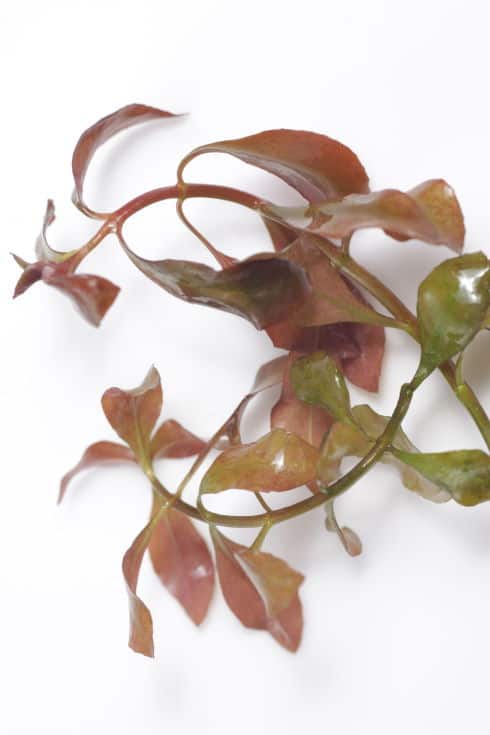
- Full name: Red Leaf Ludwigia, Red repens
- Care difficulty: Easy
- Light Level: Medium to high
Ludwigia grows partially or fully submerged in the aquarium. Underwater, the leaves range from dark green to deep red, the undersides of the leaves being red, while the top surfaces of the leaves are olive green.
The plant can grow to be 12 to 20 inches tall, making it a perfect background specimen in smaller aquariums or mid-ground plants in larger setups. Prune the plant regularly to encourage bushy growth. During the spring and summer, Ludwigia puts out small, bright yellow flowers at the water’s surface. The flowers develop seeds, which fall down to the substrate, where they grow into new plants.
Propagation is straightforward. Simply remove branches from the top of the plant and set them in the substrate. Remove the leaves from the last node on the plant’s stem to ensure that the roots grow vigorously.
10. Java Fern

- Full name: Java Fern (Microsorum Pteropus)
- Care difficulty: Super-Easy
- Light Level: Low to Moderate
The Java Fern is a super-easy plant to grow that’s a favorite with experienced hobbyists, and it’s ideal for a beginner too. The plant is simple to look after, as long as the rhizome remains above the substrate.
I have kept Java Ferns very successfully in a tank with low lighting. I love these plants because they can be tied to a piece of driftwood or rock with twine. The ferns grow very well, and you can move their home around the tank to ring the changes in your design with minimal fuss. Vacuuming your tank is also made easier, as you simply lift the plant on its base and vacuum underneath it.
The plants are slow to grow, producing baby ferns on the leaves every so often. To propagate the ferns, simply remove the new ones and fix them to any hard surface in your tank.
11. Java Moss
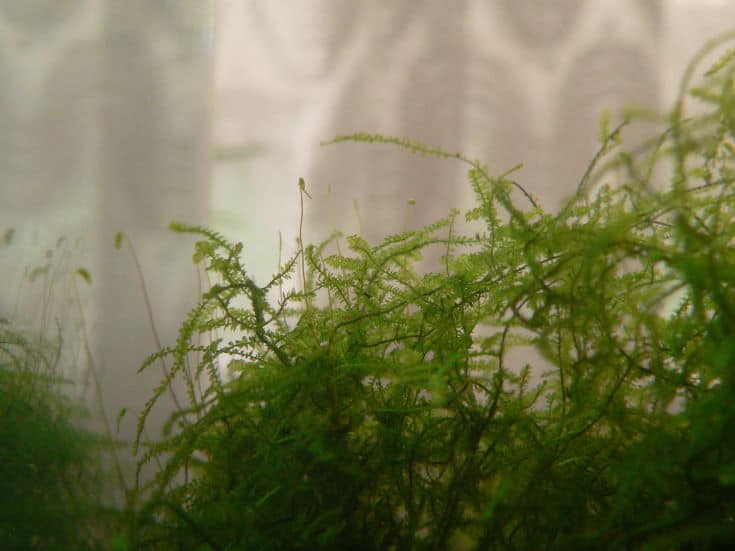
- Full name: Java Moss (Taxiphyllum Barbieri)
- Care difficulty: Super-Easy
- Light Level: Low to Moderate
Java Moss is another Southeast Asian plant that’s extremely popular with aquarists. Beginners also love this plant because it is so easy to care for and looks stunning in the tank.
The plant is extremely versatile. You can grow it planted in the substrate, where it forms a stunning, bright green carpet, attach the moss to driftwood, or allow it to grow as a free-floating plant on the water surface.
Java Moss grows well in both low and medium light settings and doesn’t require any extra fertilizer to be added to the tank. You can find Java Moss in most good fish stores and online.
12. Lemon Bacopa
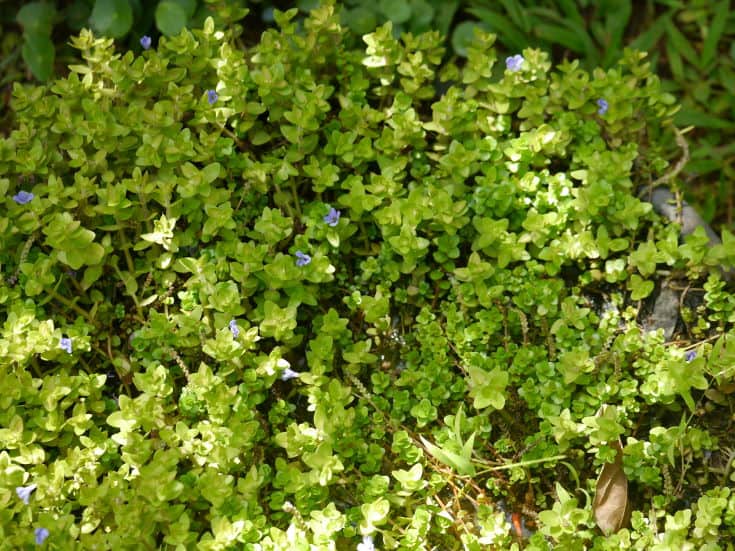
- Full name: Lemon Bacopa, Bacopa Caroliniana
- Care difficulty: Easy
- Light Level: Low to Moderate
Lemon Bacopa is a pond plant that grows well around the edges of your pond or as a trailing plant in a stream bed or waterfall setting. The plant also spreads very quickly, making it perfect for use as ground cover in a boggy area of your garden.
The plant produces bright blue flowers and bears lemon-scented foliage throughout the summer months. The plant dies off during the winter, so you’ll need to take a few cuttings and grow them in water in a sunny spot indoors.
13. Duckweed
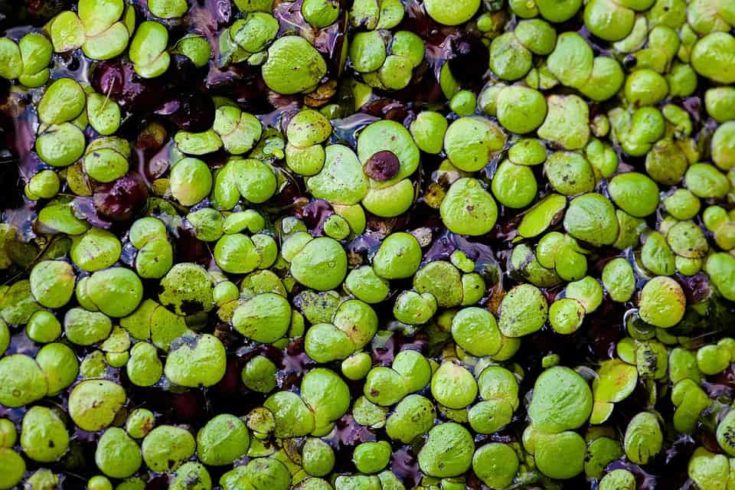
- Full name: Duckweed (Lemna minor)
- Care difficulty: Easy
- Light Level: Low to Medium
Duckweed is super-easy to grow in the aquarium and is great for helping to maintain water quality by absorbing excess quantities of nutrients from the water.
Although surface-growing Duckweed provides a great hiding place for shy fish and fry, it can be a nuisance because it grows so quickly and vigorously. When you bear in mind that Duckweed can grow to three times its original size in only one day, you can see that it needs continual maintenance to keep it under control. Left to run riot, the plant will cover the water surface, cutting out the light that plants in other parts of the setup need for growth, and preventing surface feeding fish from eating.
The easiest way to curb the overgrowth of Duckweed is to place a ring of plastic tubing on the water surface to contain the plant.
14. Hornwort
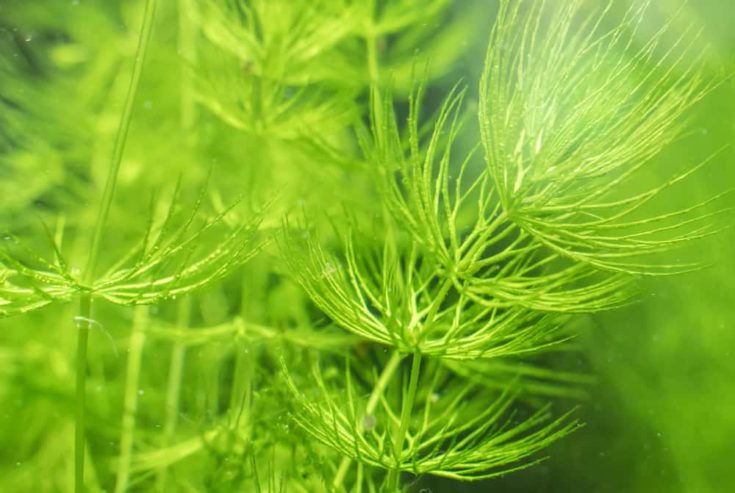
- Full name: Hornwort (Ceratophyllum demersum)
- Care difficulty: Super-Easy
- Light Level: Low to High
There are over 300 species of wild Hornwort in every continent of the world except Antarctica. So, as you can imagine, the plant is tolerant of most water temperatures, making it ideal for use in an aquarium setting.
Hornwort grows readily in the substrate or floating freely in the tank at the water surface. This is a tall plant that can easily reach the top of the water in any size or shape of a tank, meaning that you’ll need to trim the stems frequently. On the downside, Hornwort does tend to shed its bristle-like leaves, which can be a pain, especially if they clog your filter inlet.
The plant propagates via rhizomes that are produced underneath the substrate.
15. Brazilian Pennywort
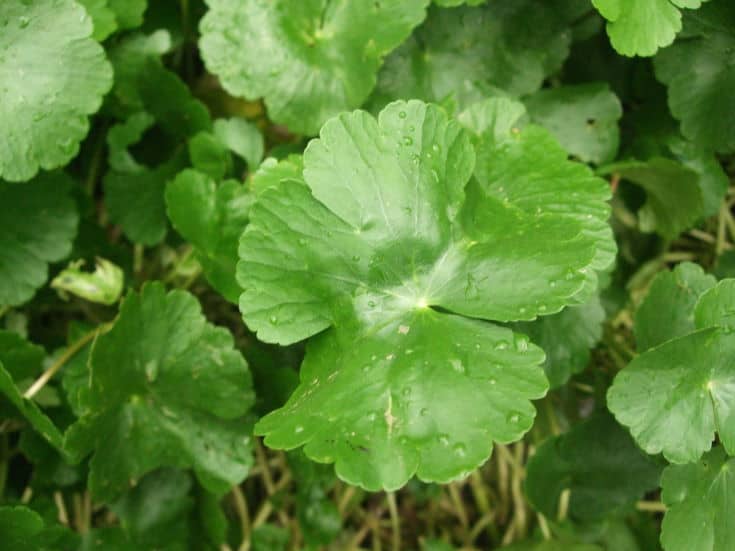
- Full name: Brazilian Pennywort, Hydrocotyle leucocephala
- Care difficulty: Easy
- Light Level: Moderate
Brazilian Pennywort is a very popular plant for aquarists because of its easy-care requirements and versatility. Pennywort comes from Southern Mexico and Northern Argentina, where it grows in wetland and marshy areas.
The plant is named for its small, penny-shaped leaves that grow alternatively on a trailing stem, quickly reaching eight inches or more in height. Once the plant reaches the water surface, it produces pretty, white blossoms. Pennywort will grow as a free-floating species or underwater. As well as providing shelter for fish, the plant is edible and can be eaten like peppery watercress in salads.
As the plant lives on the surface of the water, it doesn’t need tremendously bright light to thrive. Keep the plant’s growth in check by trimming it regularly.
16. Anubias Nana

- Full name: Anubias Barteri var. Nana
- Care difficulty: Super-Easy
- Light Level: Low to High
Anubias nana is very popular with betta owners. Not only is the plant suitable for use in a small tank, but it has wide leaves that provide a perfect resting place for a lazy betta fish. The plant is also easy to care for, grows in low to medium light, and is, therefore, suitable for a beginner hobbyist.
Anubias is a slow-grower and doesn’t get particularly large at maturity, reaching just seven inches in height, so it’s ideal for a small tank. If you keep ornamental snails, it’s worth knowing that they won’t eat Anubias nana’s tough, bitter leaves.
You can grow the plant attached to wood or rocks, or it grows as a root feeder when planted in the substrate too. To create new plants, simply split the rhizomes, and attach the baby plants to a piece of driftwood or a rock or plant them in the substrate.
17. Moneywort
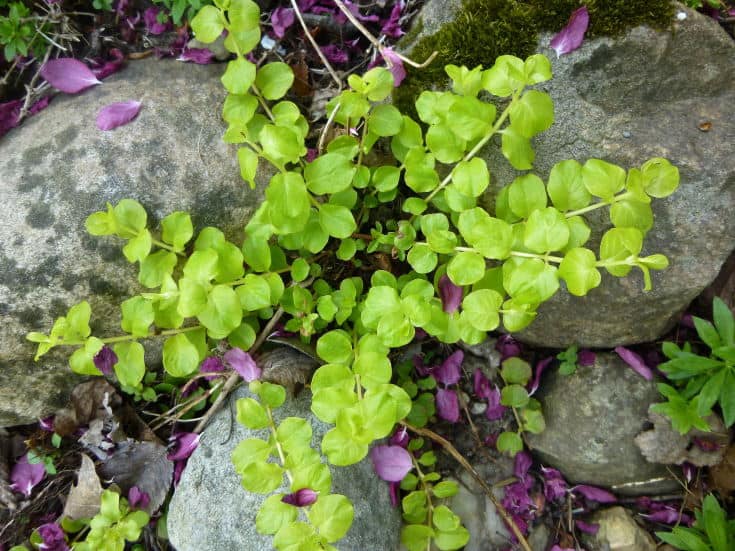
- Full name: Moneywort, Brahmi, Bacopa monnieri
- Care difficulty: Easy
- Light Level: Medium to High
Moneywort is suitable for a beginner, as it is easy to grow and requires little maintenance. The elliptical leaves grow alternately along the stem and are a very attractive, vivid, bright green. The plant grows either partially or fully submerged.
Moneywort can reach 12 inches tall under medium light conditions, and the branches will grow right out through the water surface if it’s left untrimmed. You can propagate Moneywort by cutting the stems where white roots begin to appear at the leaf nodes.
Alternatively, allow the plant to grow right up to the surface, where it will begin to grow horizontally along the water surface and put out white roots at each leaf node. Once the roots reach two inches in length, cut each rooted section, and plant them in the substrate.
18. Bucephalandra
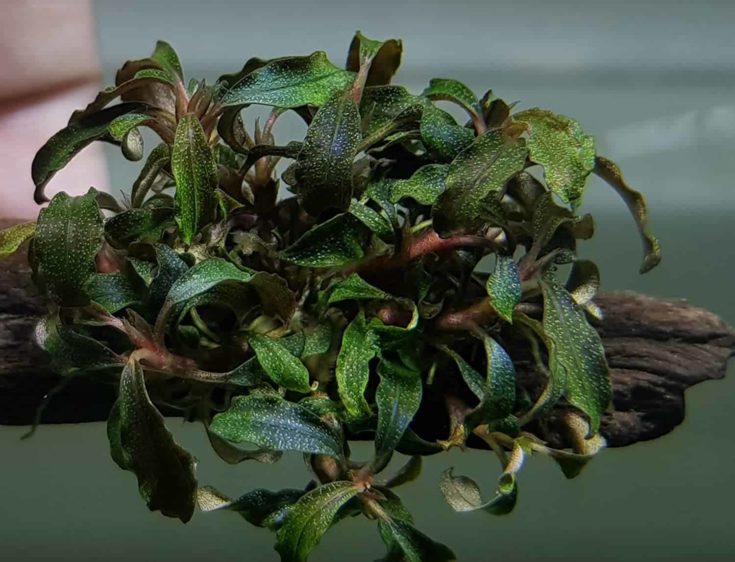
- Full name: Bucephalandra, Buce
- Care difficulty: Easy
- Light Level: Low to High
The Bucephalandra plant is also known as Buce. Buce is a favorite with many aquarists, despite being a relatively new addition to the array of aquarium plants on offer in fish stores.
There are over 30 varieties of Buce, each unique in color, shape, and size. These slow-growing plants are easy to grow, although you will need to be patient. Once mature, the plant can attain up to ten inches in height. The growth rate of Buce is directly linked to the amount of light it receives. So, the lower the light levels in your tank, the slower the plant will grow.
Unfortunately, Buce does tend to attract algae, so you will need to clean the leaves regularly to keep the plant looking nice unless you have a clean-up crew of shrimp in your tank.
19. Dwarf Hygro
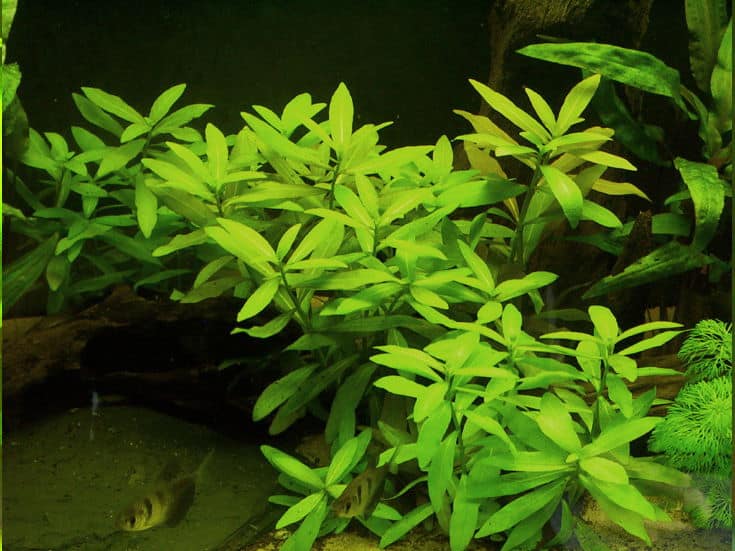
- Full name: Hygrophila polysperma, Indian waterweed, Dwarf Hygrophila
- Care difficulty: Easy
- Light Level: Low to Medium
Dwarf Hygro is one of the hardiest plants that you can buy for your fish tank. The plant doesn’t need any special care and will grow well, even in the most basic setup.
You can grow the plant as a mid to background plant in your tank in low to medium light conditions, but the main drawback to this plant is that it does grow rapidly in a well-maintained tank that contains plenty of nutrients. So, you will need to plan to carry out regular pruning to prevent the plant from running riot.
To propagate Dwarf Hygro, pinch a segment from the plant and set it in the substrate. The plant is so easy to grow that you can create a whole new plant from just one leaf!
20. African Water Fern
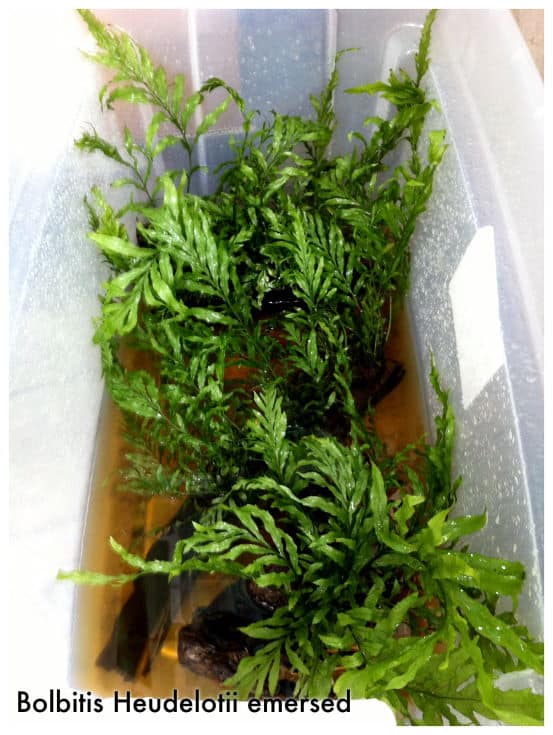
- Full name: African Water Fern, Congo Fern, Bolbitis heudelotii
- Care difficulty: Easy
- Light Level: Low to Medium
African Water Ferns are found throughout the Congo River Basin in Africa, where they grow in boggy areas and streams.
The plants are very slow to grow, but they can eventually reach eight inches in width and 22 inches tall. To grow the ferns, attach them to pieces of driftwood or rocks using twine. To propagate the plants, use a pair of sharp aquascaping scissors to remove new plants from the rhizome. A combination of both mature and young African Water Ferns makes a beautiful picture, as the older plants are dark green in color, whereas younger ones are a much brighter and more vivid green.
21. Pygmy Chain Sword
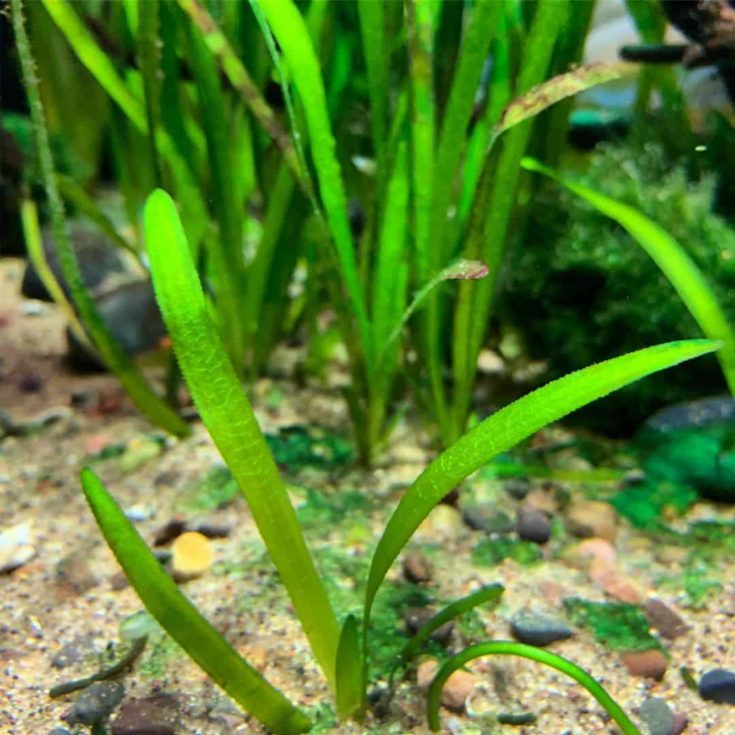
- Full name: Pygmy Chain Sword Plant (Echinodorus tenellus)
- Care difficulty: Moderate
- Light Level: Medium to High
If you’re looking for a carpet plant, the Pygmy Chain Sword could be what you’re looking for. The plants are very easy to grow and are tolerant of a wide range of water conditions and temperatures. That said, the plants do need medium to high light levels, and the addition of extra nutrients and CO2 will encourage better growth and spread. These plants are best suited to shallow tanks, where they can be grown in the foreground to create a lush, vibrant green lawn.
The Pygmy Chain Sword self-propagates by pushing runners out through the substrate. The runners carry small new plants, which create a lawn effect on the aquarium floor, as the plant spreads. Periodically, you will need to pinch out a little of the growth to control the spread of the plants.
22. Pellia Moss
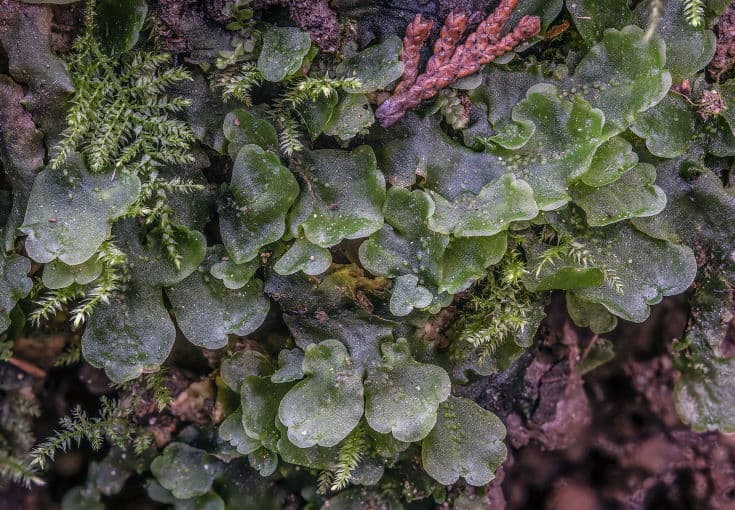
- Full name: Pellia Moss, Monosolenium tenerum
- Care difficulty: Easy
- Light Level: Medium to High
Pellia Moss is a species of liverwort that comes from east Asia. This weedy moss is very easy to grow in pretty much any environment, growing into bushy shapes and putting out leaves that are similar in shape to a stag’s horns. The moss is a rich green color, giving a fresh, natural look to your aquarium.
The plant is robust and easy to look after, requiring a medium amount of light and tolerating acidic or alkaline water. Pellia moss makes the perfect complement to yellow, purple, and red plants and placed in the middle to the foreground of the tank.
23. Marsh Seedbox
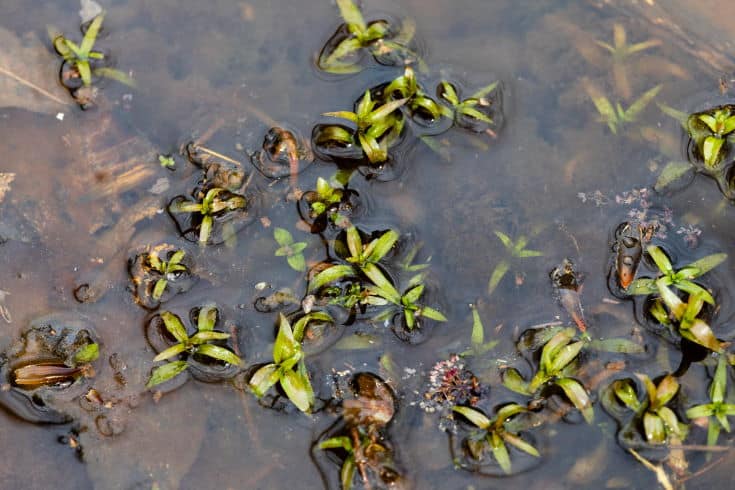
- Full name: Marsh Seedbox, Ludwigia palustris, Water Purslane
- Care difficulty: Easy
- Light Level: Medium to High
Marsh Seedbox is sometimes also known as Water Purslane. Provided that the plant receives the correct care, it makes a striking addition to the background or mid-ground of your aquarium. Water Purslane has beautiful red leaves that can become incredibly intense if the plant is supplemented with nutrients, including iron.
Unlike many red plants, Marsh Seedbox can flourish with only medium levels of lighting, making it a good choice of aquarium plants for small setups. However, it’s worth noting that if the levels of light are too low, the plant may become more green than red.
To propagate Water Purslane, all you need to do is take cuttings and replant them in the substrate.
24. Amazon Frogbit
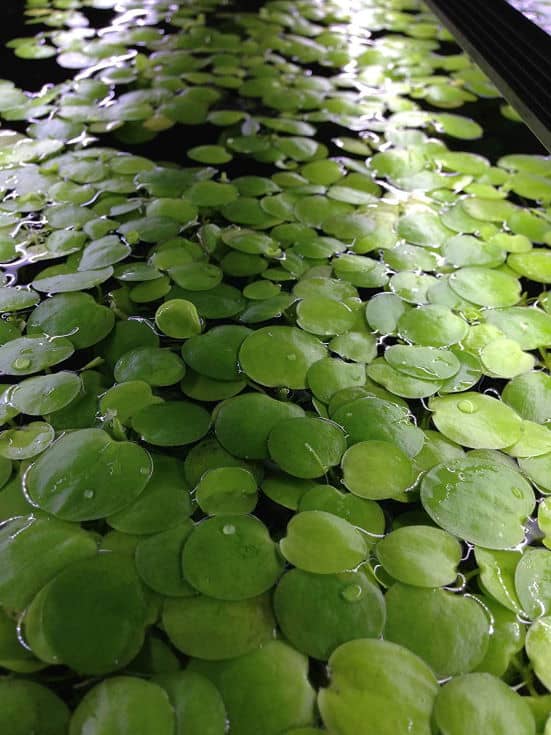
- Full name: Amazon Frogbit (Limnobium laevigatum)
- Care difficulty: Super-Easy
- Light Level: Low to High
If you don’t want to put Duckweed in your tank, but you’re looking for a nice surface plant, Amazon Frogbit could be what you need.
Frogbit doesn’t take over like Duckweed can. The plant is larger than Duckweed, too, making it much easier to keep looking tidy. Frogbit sends out long, tangled root systems that dangle down from the surface of the water, forming a labyrinth of corridors and caves that make ideal hideouts for shy fish species and vulnerable fry. The plant also helps to purify the water in your tank by sucking up excess nutrients and nitrates that are produced by your fish.
To prevent Frogbit from cutting out the light for anything living beneath it, use a ring of plastic tubing to restrict the plant’s growth area and spread.
25. Bladderwort
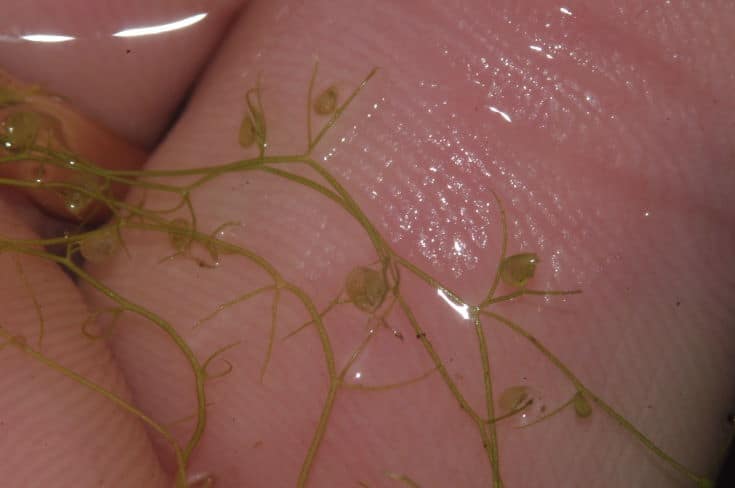
- Full name: Bladderwort, Utricularia graminifolia
- Care difficulty: Moderate
- Light Level: Medium
There are many varieties of bladderwort, including the free-floating aquarium plant, Utricularia graminifolia that comes from Asia, although it is also found in North America. In nature, the plants tend to occur in areas where nutrients are scarce, hence all the varieties of bladderwort have evolved to catch and consume small insects and digest them.
These perennial marsh plants form a bladder trap once the plant has become established in the aquarium. Once established in the tank, the plant puts out a forest of fresh, green leaves that create an attractive mat effect that resembles a lawn. Therefore, Utricularia graminifolia is often chosen as a foreground plant. You can also take cuttings from the plant and grow them in an outdoor pond if you have one.
26. Giant Hygro
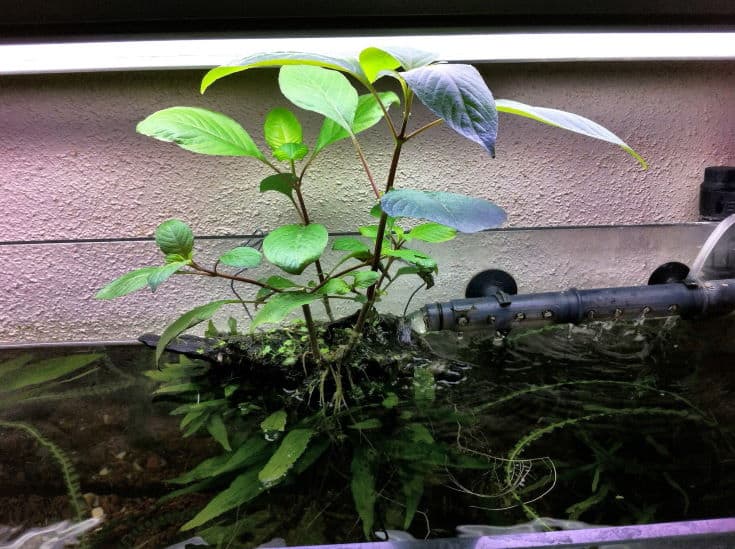
- Full name: Giant Hygro, Hygrophila corymbosa, Temple Plant
- Care difficulty: Moderate
- Light Level: Medium
Giant Hygro is a fast-growing plant that comes from Asia. The leaves are long, narrow, and pointed, growing up to five inches in length. The plant can grow to reach 24 inches in height, and it can become quite dense and bushy if it’s kept in the correct conditions. The leaves are bright green, although if the lighting in your tank is bright enough, the leaves can take on a pinkish or red hue.
Because the plant grows so fast, it can be extremely useful as a cycling plant, removing excesses of ammonia, nitrite, and nitrate from the aquarium water and helping to maintain good conditions for your fish. The plant is also able to adapt to tolerate a very broad range of water conditions, so it can be a good choice for cichlid tanks.
You can propagate Giant Hygro by taking cuttings from the plant and replanting them in the substrate.
27. American Waterweed
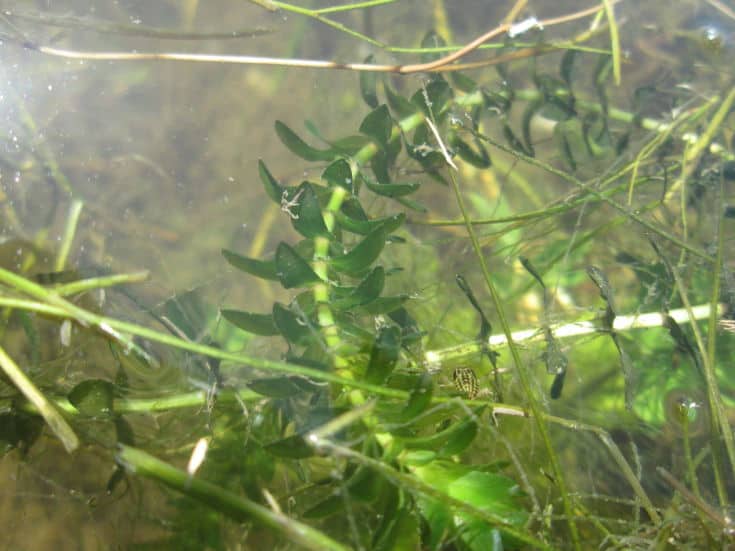
- Full name: American Waterweed, Hydrocharitaceae, Elodea
- Care difficulty: Moderate
- Light Level: Medium
American waterweed is a very easy-to-grow aquarium plant that makes a good background specimen, often growing tall enough to reach the water surface.
The plant is dark green with long, hollow stems, bearing whorls of three leaves, terminating in a dense cluster of leaves at the end of each branch. In the springtime, the plant puts out small white flowers that bloom at the water surface attached to delicate stalks. During the winter months, the plant produces buds that overwinter on the tank bottom.
American waterweed is very easy to propagate. Simple snip a segment from the plant and root it in the substrate. Once established, the plant grows vigorously, and you will need to trim it regularly to prevent it from overrunning the tank.
28. Anubias Barteri
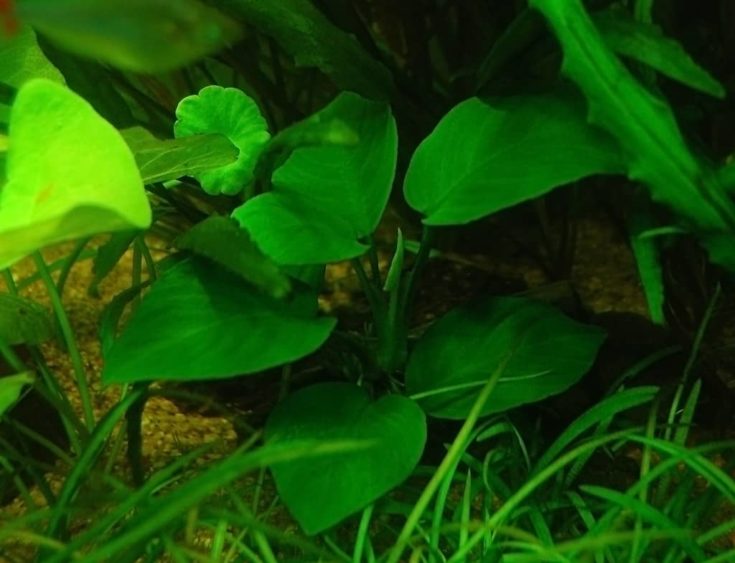
- Full name: Anubias Barteri (var. barteri)
- Care difficulty: Super-Easy
- Light Level: Low to High
Anubias barteri is a West African plant that is extremely hardy when grown in a tropical aquarium.
As with most varieties of Anubias, barteri is a slow-grower. That’s great, as it makes the plant pretty low-maintenance and easy to grow, especially as it will tolerate a wide range of light and water conditions. The plant’s tough leaves aren’t appetizing to snails or fish, although they do tend to accumulate algae, which you will want to remove.
The plant grows to reach between 18 and 24 inches in height and can be grown attached to rock or driftwood. Note that you must not bury the rhizome in the substrate, as that will cause the plant’s root system to rot. When the plant is established, it sometimes produces a flower spike, bearing a scented, white flower once it breaks the water surface.
29. Staurogyne Repens
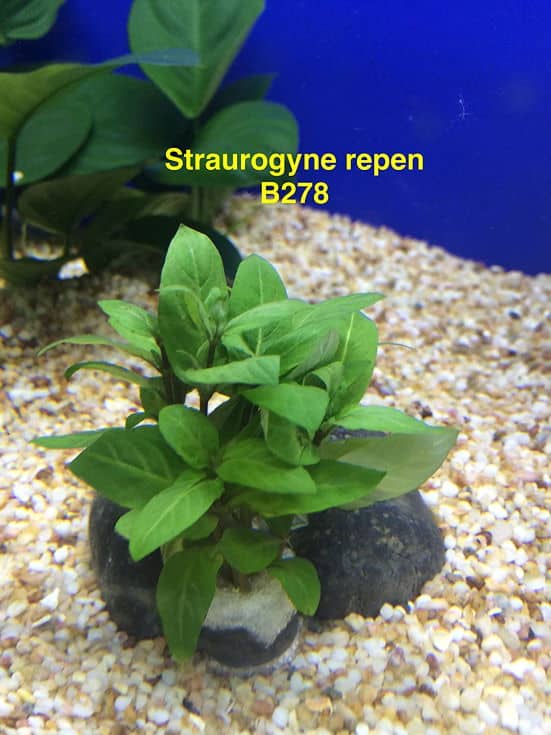
- Full name: Staurogyne Repens
- Care difficulty: Easy
- Light Level: Medium to High
Staurogyne Repens is an attractive foreground or mid-ground plant with a bushy, compact habit that makes it ideal for the front of your tropical fish tank. The plant has small, fresh green leaves that grow on stiff, brownish stems.
The plant is usually supplied in small pots. When planting Staurogyne Repens, cut off the longest upright shoots, remove the plant from the pot, and divide it into four pieces. You can then plant the pieces close to each other in small groups. In cutting off the emergent shoots, you will keep the plant compact in form.
Once the plant is established, it puts out horizontally creeping shoots from its base, which quickly form a lovely carpet across the substrate.
30. Guppy Grass
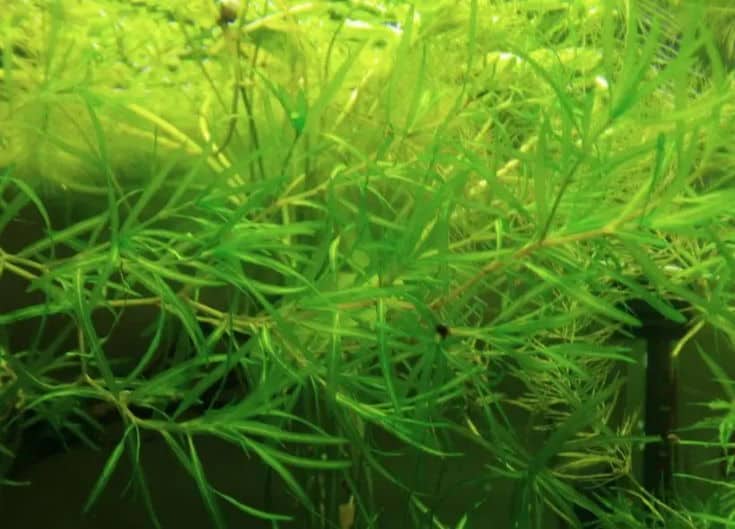
- Full name: Guppy Grass, Najas guadalupensis
- Care difficulty: Easy
- Light Level: Medium
Guppy Grass is also known as Najas Grass. This is a very versatile plant that you can grow as a rooted or free-floating plant. The plant was named for its habit of providing a floating mat of cover that makes an ideal hiding place for guppy fry.
The plant thrives under medium light and performs a very useful task in your aquarium by removing heavy metals, ammonia, nitrite, nitrates, and heavy metals from the water. Guppy Grass consumes pretty much every free nutrient in the tank, thus preventing algae from gaining a foothold.
The plant self-propagates, so you will need to trim it back regularly to keep it under control. One very interesting fact about Guppy Grass is that it changes its leaf shape, depending on how it’s grown. So, if the plant is rooted in the substrate, the leaves look different than they do if the plant is growing as a free-floating specimen.
31. Christmas Moss
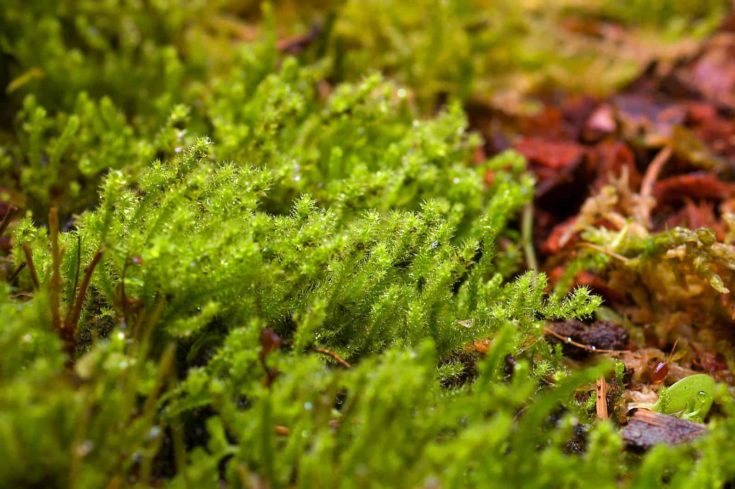
- Full name: Christmas Moss (Vesicularia montagnei)
- Care difficulty: Super-Easy
- Light Level: Medium
Christmas Moss is another moss species that is a great choice for beginners, as it’s hardy and very easy to grow. The moss is a tropical species that grows best in a tank with water in the range 78o and 80o Fahrenheit.
Christmas Moss spreads extremely easily, growing in neat little bunches, rather than overrunning the whole tank. This is an extremely attractive variety of moss whose leaves resemble fir trees, hence the plant’s common name. Christmas Moss looks particularly beautiful when grown as a carpet across the floor of the tank, where it resembles a forest of miniature trees.
32. Peacock Moss
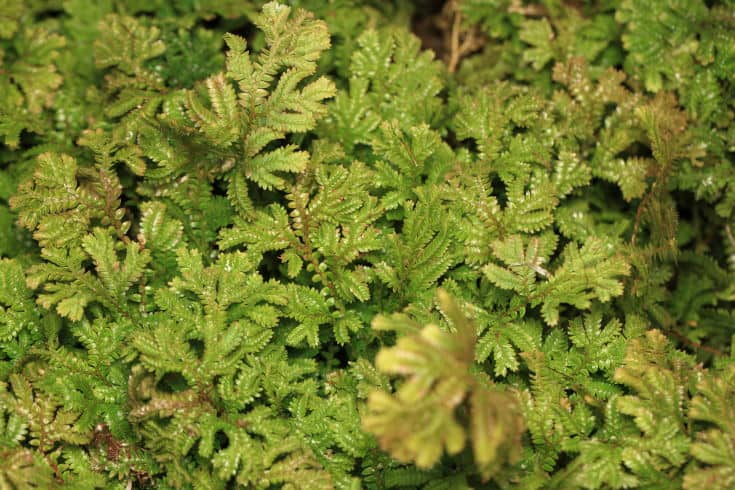
- Full name: Peacock Moss (Selaginella uncinata)
- Care difficulty: Easy
- Light Level: Medium to High
Peacock moss is a very unusual moss species that is not often seen in the aquarium hobby. The plant is a member of the Selaginellaceae family of mosses and looks similar to Christmas moss but has a tighter formation and more triangular design.
Peacock Moss is incredibly easy to grow. The plant has a horizontal growth habit that lends itself perfectly to being fixed to rocks and driftwood with twine. Although the plant will grow in medium lighting conditions, it is happier when grown in a brighter environment. To encourage the plant to thrive, add supplements to the water.
33. Awl-Leaf Arrowhead
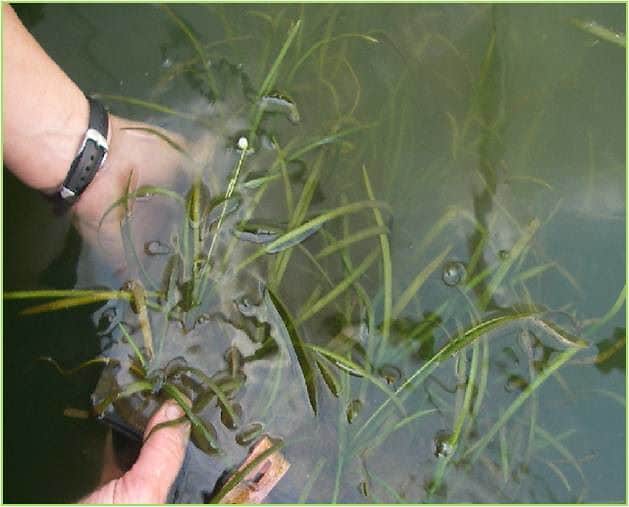
- Full name: Awl-Leaf Arrowhead (Sagittaria subulata)
- Care difficulty: Easy
- Light Level: Medium
Awl-Leaf Arrowhead is also known as Dwarf Sagittaria and Narrow-Leaved Arrowhead. This aquarium plant is a good choice for a low-tech tank with medium lighting, being easy to grow, and not too demanding when it comes to maintenance.
The plant has long, thick grassy leaves that form a carpet when planted in dense numbers. The plant reaches just a few inches in height and, if allowed to do its own thing, sends out runners that eventually create a luxuriant mat effect across the floor of your aquarium.
Alternatively, you can plant Awl-Leaf Arrowhead less densely so that it grows taller, potentially reaching the water surface where it will produce small, white flowers. You can create new colonies of the plant by pinching off the runners and planting them in the substrate.
34. Pogostemon Helferi
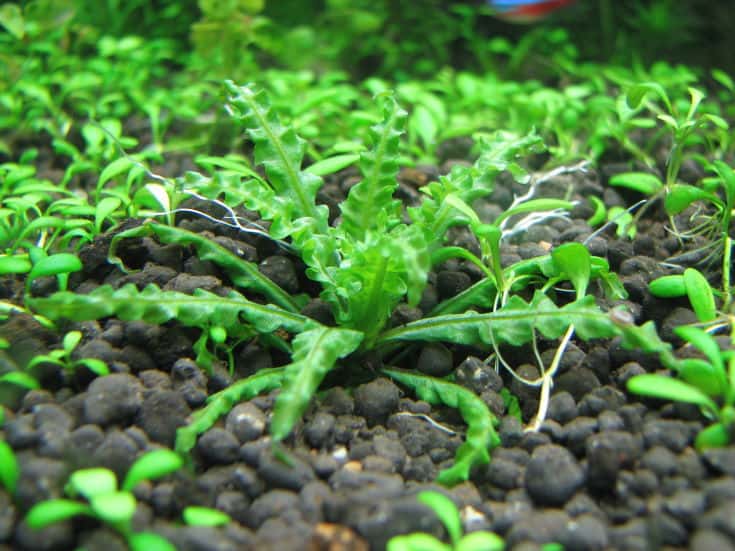
- Full name: Pogostemon Helferi
- Care difficulty: Moderate
- Light Level: Medium
Pogostemon helferi is an unusual aquarium plant that makes a great choice for a foreground position in your setup if you’re looking for something a little bit different.
When provided with optimum growth conditions, the plant’s curly, dark green leaves form a dense carpet. Although the plant will grow in poor light conditions, if given more light, it will form short internodes that give the plant a bushy, compact look. The plant’s stems grow up to six inches long, and it produces pretty lavender-colored flowers when they emerge.
Although you can grow the plant in low light conditions, it will grow taller as it pushes toward the light source. Because Pogostemon helferi is a fast-growing plant, it does require additional nutrients or iron deficiency can occur, which causes the plant’s new leaves to turn yellow. You can keep the plant’s bushy habit by regularly trimming away the longest shoots.
35. Micro Sword
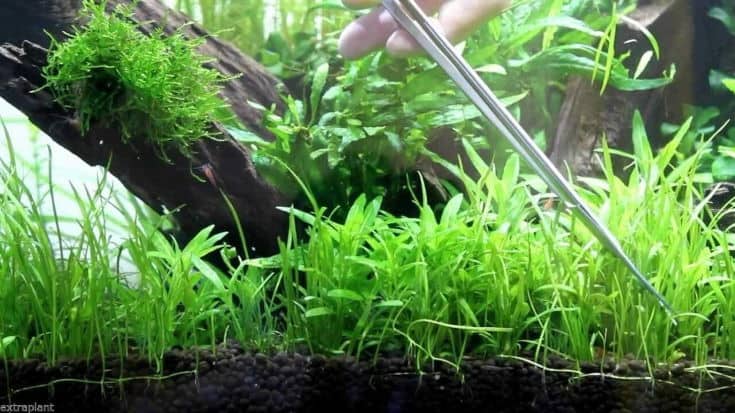
- Full name: Micro Sword, (Lilaeopsis brasiliensis)
- Care difficulty: Moderate
- Light Level: Medium
Micro Sword is an attractive low-growing plant that is relatively easy to care for. To produce the best growth rate, you will need to provide the plants with supplementary fertilizer, especially in a low-tech tank setup without a nutrient substrate.
These plants have very delicate, fine roots, so you must be very careful when planting or propagating Micro Sword. Gently place the plants into the substrate, and anchor them with pebbles to prevent them from floating away until the roots have become established. When given the right conditions, Micro Sword can grow into a green, grassy carpet about two to five inches tall.
The Micro Sword plant reproduces by sending out runners. To propagate the plant, gently snip off the runners and replant them in the substrate.
36. Marimo Moss Balls
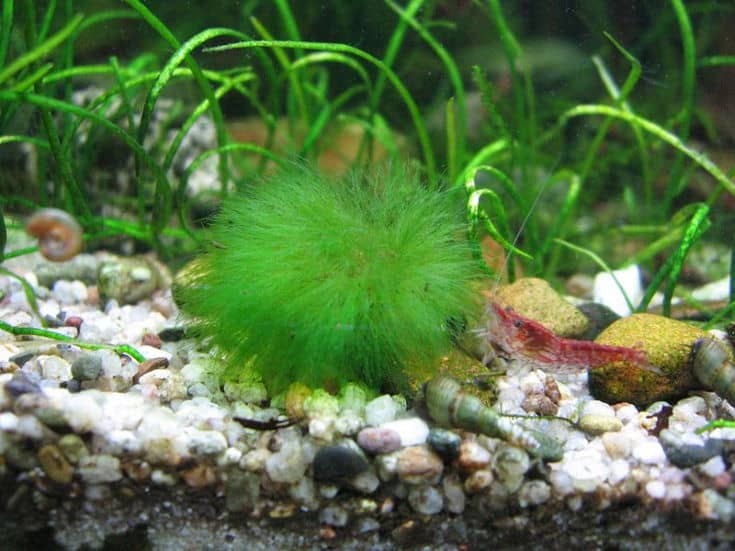
- Full name: Marimo Moss Balls (Aegagropila linnaei)
- Care difficulty: Moderate
- Light Level: Low
Marimo Moss Balls are a favorite of aquarists everywhere and can be bought from almost every fish store.
These are not plants, but a species of vivid green algae that are spherical in shape. Marimo Moss grows on lake beds, where they are shaped into their strange round form by the gentle action of water currents.
Moss Balls are perfect for a low-light tank, and they prefer cool water, which means that you can keep them in a cold water tank. This form of algae prefers water with very low levels of ammonia, nitrites, and nitrates, and few nutrients.
Although fish and invertebrates seem to love Marimo Moss Balls in their tank, you may find that they lose their shape over time if the flow in your tank is too slow.
37. Liverwort
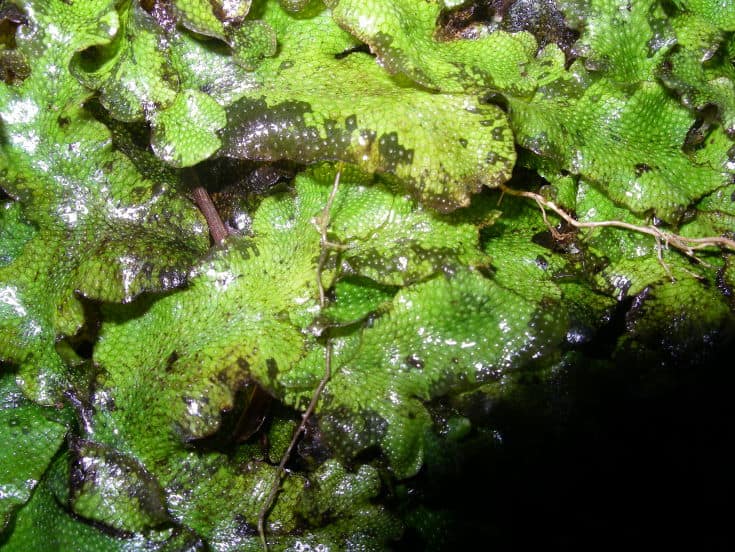
- Full name: Liverwort, (Monosolenium Tenerum)
- Care difficulty: Moderate
- Light Level: Low
Liverwort is an aquatic plant that comes from small regions in Asia, where it is actually quite rare in the wild. Although it does look very much like a kind of moss, liverwort belongs to its own Liverwort genus.
Liverwort doesn’t have leaves. The green part of the plant that appears to be its leaves is called “thallus.” Every thallus divides into fork-like branches, creating a cushion. Liverwort can make a very unusual foreground plant, but, unfortunately, it doesn’t attach to the substrate very well and tends to break easily. You can prevent that from happening by using thread to attach your plant to a rock or piece of driftwood.
This plant self-propagates by releasing spores from the tips of its leaves. The spores are carried around the aquarium by the water flow before finally settling somewhere and forming a new colony of Liverwort.
What Do Low Light Conditions Mean?
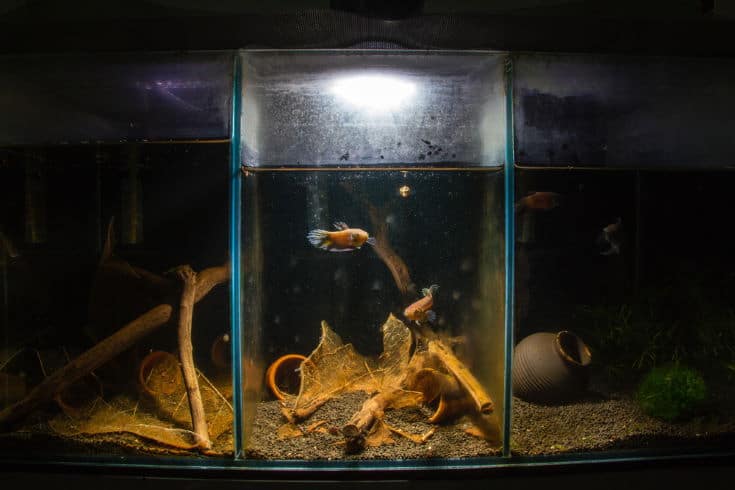
Light is crucial for healthy growth, even for low and medium light aquatic plant species. In addition to drawing nutrients from the water, plants need light for photosynthesis, the process that enables plants to grow and thrive.
Most experienced hobbyists consider low light plants to be those that require 3 watts of light or less per gallon of water; put another way, low light plants need just 15 to 25 lumens. Medium-light plants need a little more brightness, requiring up to 50 lumens.
So, what’s the difference between watts and lumens, and how do you measure them?
Watts VS. Lumens
Watts are the measure of electricity that’s used by a device, in this case, your aquarium light fitting. Essentially, a watt refers to the usage or consumption of the particular device and has nothing to do with the light output of the light bulbs.

Lumens are a measure of visible light that is emitted from a light source, which can be measured using a light meter.
LED lighting is the most energy-efficient and cheapest option, and it’s also the best choice for a planted tank. That’s because most LED light fittings allow you to choose the color and brightness of the lighting effect so that you can customize it to best suit the plants in your tank.
So, to summarize, plants that prefer low light conditions generally need less than 3 watts of light per gallon of water in the tank. All aquatic plants require between eight and 12 hours of light per day.
Column Feeders VS. Root Feeders
Aquatic plants are separated into two groups, depending on how they obtain nutrients from the aquarium.
Column Feeders
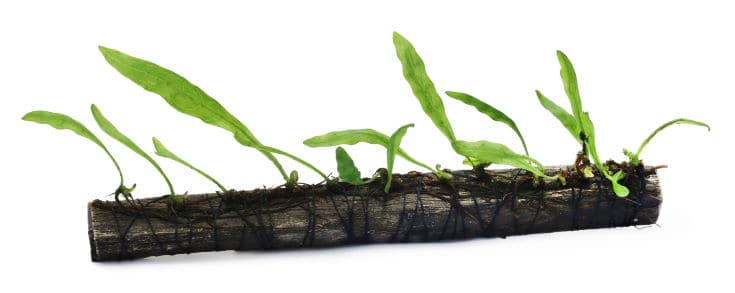
Column feeders are plants that can happily live above the substrate, drawing nutrients from the tank water through their rhizomes. A rhizome is also described as a “creeping rootstalk,” and in the case of aquatic plants, the rhizomes can sit above the substrate.
Root Feeders
Root feeders absorb nutrients through their root systems from what’s available in the substrate. For that reason, you need to provide root feeders with a gravel substrate that has space for interstitial, nutrient-bearing water between the fragments of gravel and provides the plants with a firm anchor point.
When planning the perfect aquascape for your tank, you’ll need to know how the plants you’ve chosen derive the nutrients that they need. That way, you can site your plants correctly in the aquarium so that they thrive.
Basic Supplies Needed To Care For Low To Medium Light Plants
Although none of the plant species that we’ve included in our list need a huge amount of specialist care, the following items may help your plants to attain optimal growth and keep them healthy too.
- Root Tabs
- Liquid Fertilizer
- CO2
Substrate and Laterite
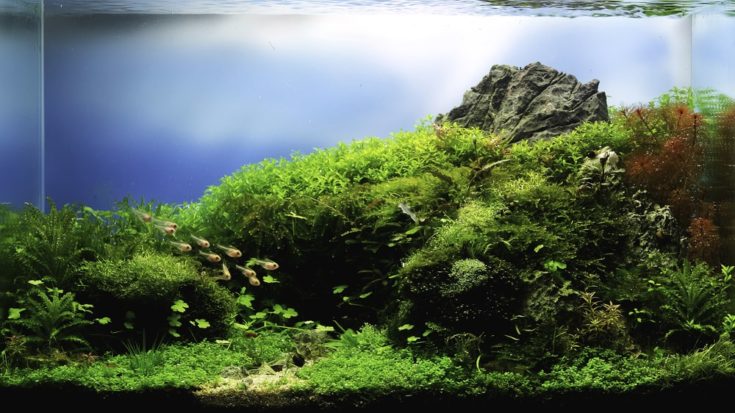
When you buy aquarium plants, they generally come in a pot or in a loose bunch, depending on the species and growth habit. Plants can grow in pretty much any kind of substrate, but the best medium is two to three inches of a nutrient layer, such as laterite, (a combination of rock and soil that’s rich in aluminum and iron), underneath an inch or so of a larger, regular substrate, such as gravel.
When you plant potted plants, I recommend removing them from their pots and placing them directly into the substrate, as that helps to encourage the roots to spread and grow. Larger plants tend to have more complex root systems that require lots of room to spread out, so you will need a slightly deeper layer of gravel to accommodate that.
Check out the best substrate for your planted tank here.
Maintenance Tips For Low To Medium Light Plants
If you plant and maintain your aquatic plants correctly, they’ll flourish. Here are a few basic maintenance tips to guide you.
Cleaning The Plants Before Planting
Anything that you put in your tank may potentially be carrying harmful bacteria or parasites. So, before you add plants to your aquarium, rinse the plants under tap water, prune off dead leaves, and remove any snails.
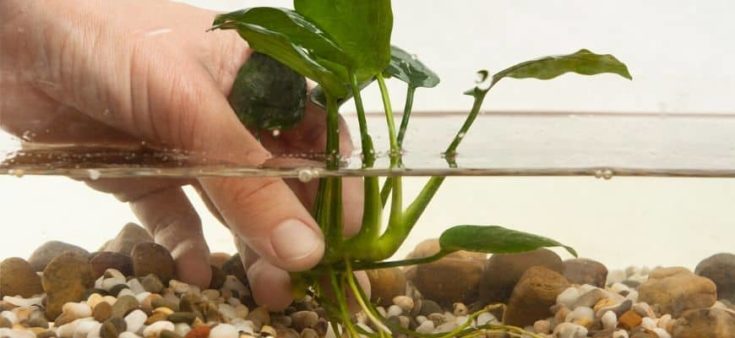
Make up a solution of tap water and distilled white vinegar in the ratio of 1 part vinegar to 1 part water, and soak the plants for five minutes, then rinse under running tap water. That will get rid of bacteria, parasites, and algae spores before you add the plants to your tank.
Cleaning Algae From Aquarium Plants
Algae can be a problem if it becomes established on the leaves of your live plants, and it’s worth adding a few algae-eating species to your community to keep the problem under control.
Alternatively, you’ll need to remove the plants from the tank and soak them in a solution of 1 part distilled white vinegar to 1 part tap water for five minutes. Rinse the plants under tap water, and return them to the tank.
Removing Snails
Snails can be a problem in a tank, as they may eat your plants. You can get rid of snails by making up a solution of tap water and Kosher salt in the ratio of one cup of salt per gallon of water.
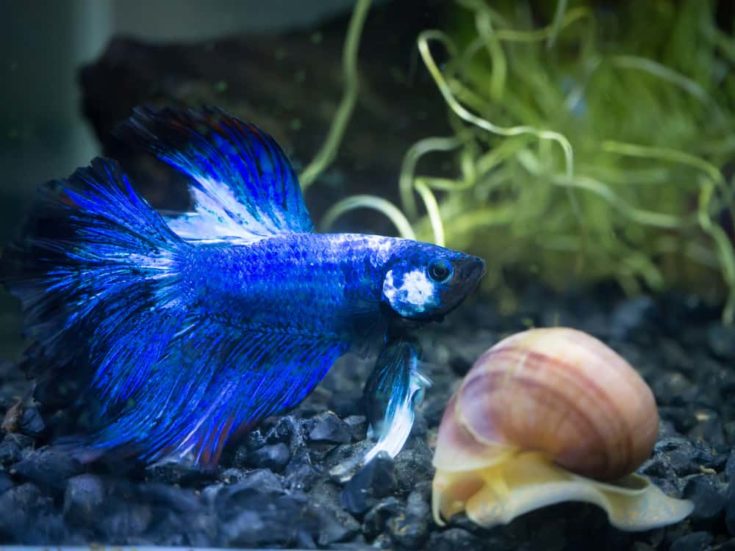
Rinse the plants in the solution, taking care to hold the roots above the water. Rinse the plants in dechlorinated water and replace them in your tank.
Trim Your Plants
Some species of aquatic plants grow very quickly, so you’ll need to trim them from time-to-time so that they don’t overrun the tank.
Invest in a set of aquascaping tools for the job, and remove overgrowth by carefully trimming the plant stem close to the substrate. Floating species of plants can be tidied up by trimming off straggly areas of the plant. Use the tweezers in your kit to remove dead or damaged leaves.
In Conclusion
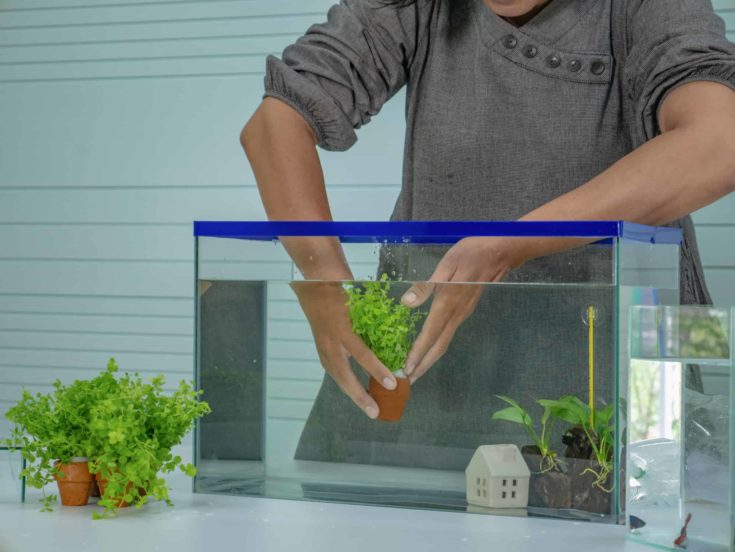
If you’re just starting out as an aquarist, you’ll find a selection of plants in our list that will be ideally suited to a low to medium light setup. Most of the plants we’ve listed don’t need any additional supplements, although you can promote optimum growth if you do feed your living flora.
Living plants are great for fish tanks!
- Plants provide perfect hiding places for shy fish and vulnerable fry.
- Live plants help to keep the water in the aquarium clean by absorbing ammonia, nitrites, nitrates, and heavy metals.
- Live plants add a beautiful, natural feel and look to the tank that you will love.
If you enjoyed our guide to the best low and medium light aquarium plants, be sure to tell us what you thought in the comments box below.
Interested in growing Lucky Bamboo in your fish tank? Check our guide here.
